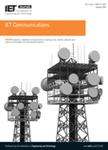版权所有:内蒙古大学图书馆 技术提供:维普资讯• 智图
内蒙古自治区呼和浩特市赛罕区大学西街235号 邮编: 010021

作者机构:Xidian Univ State Key Lab Integrated Serv Networks ISN Xian 710071 Peoples R China
出 版 物:《IET COMMUNICATIONS》 (IET Commun.)
年 卷 期:2014年第8卷第6期
页 面:885-892页
核心收录:
基 金:National Basic Research Program of China [2012CB316100] '111' project [B08038] National Natural Science Foundation of China [61101144, 61101145] Fundamental Research Funds for the Central Universities [K50510010017]
主 题:cognitive radio optimisation radiofrequency interference telecommunication traffic network coding optimal power allocation asymmetric analogue network coding cognitive radio two-way relay channel analogue network coding protocol secondary user interference power threshold primary user optimisation problem equal power allocation cheme traffic symmetry
摘 要:In this study, the optimal power allocation (OPA) problem is studied for the two-way relay channel employing the analogue network coding protocol with the asymmetric traffic requirements in a cognitive radio network. The OPA scheme is proposed by maximising the sum-rate of the success delivery bit from the secondary user (SU) perspective subject to the sum-power constraint and the interference power threshold (IPT) constraints to the primary user (PU). In particular, for the purpose of accomplishing the power allocation more realistically, the interference to each other between the PU and the SU and the relay is taken into consideration and by solving the optimisation problem composed for each case, the closed form expressions of each node power are obtained. All the simulation results have demonstrated that the system with the proposed scheme outperforms the equal power allocation (EPA) scheme irrespective of the IPT. When the IPT constraint is introduced, the sum-rate of the success delivery bit of the SU communication converges to a certain level with the increasing total power. Meanwhile, the proposed strategy is superior to the conventional EPA scheme for any relay location, which is more remarkable when the relay is located on either end node regardless of the traffic symmetry or the asymmetry.